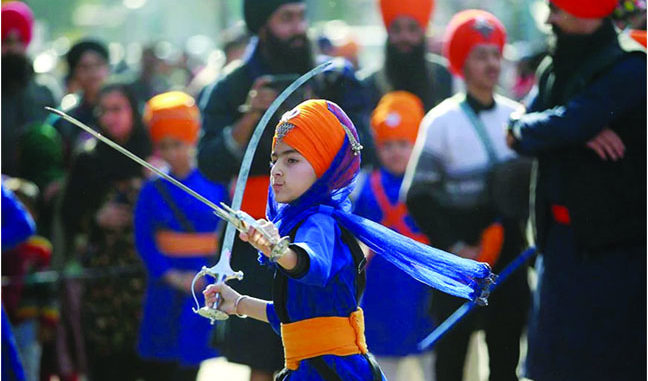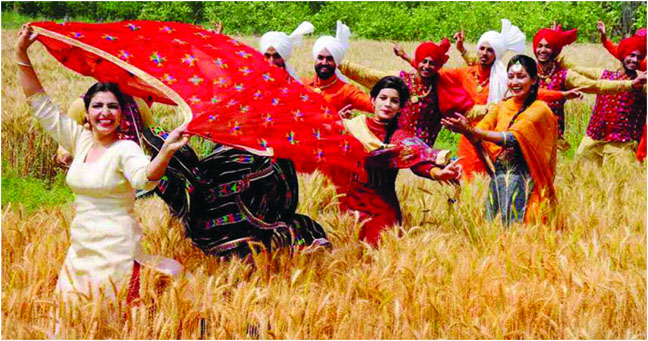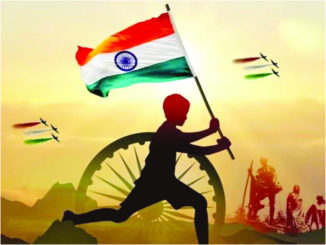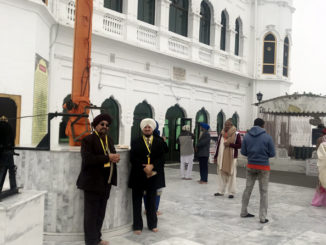
Baisakhi (also called Vaisakhi) is a harvest festival which is celebrated on the thirteenth day of April according to the solar calendar. This day marks the beginning of the Hindu solar new year. In fact this day is celebrated all over the country as new year day under different names. It is celebrated in North India, particularly in Punjab and Haryana, when the rabi crop is ready for harvesting. It usually falls on April 13, falling on April 14 once every thirty-six years. It coincides with ‘Rongali Bihu’ in Assam, ‘Naba Barsha’ in Bengal, Puthandu in Tamil Nadu and ‘Pooram Vishu’ in Kerala.
Significance of Vaisakhi
Baisakhi has a special meaning for the Sikhs. Baisakhi Festival is celebrated as the Sikh New Year and the founding of the Khalsa Panth. On this day in 1699, their tenth Guru Gobind Singh organized the order of the Khalsa and administered amrit (nectar) to his first batch of five disciples making them Singhs, a martial community. Again, on this day in 1875, Swami Dayanand Saraswati founded the Arya Samaj-a reformed sect of Hindus who are devoted to the Vedas for spiritual guidance and have discarded idol worship. This day is once again of immense religious import to the Buddhists because Gautama Buddha attained enlightenment and Nirvana on this auspicious day.
Celebrations
Festival of Baisakhi is celebrated with lot of joy and enthusiasm in the northern state of Punjab and Haryana. The farmers perform their own prayers and rejoice. For on this day, they commence cutting their harvest. Dressed in their typical folk attire, both men and women, celebrate the day with Bhangra and Gidda. Sweets are distributed, old enmities are forgiven and life is full of joy, merriment and everyone seems to belong.
Fairs are organized at various places in Punjab, where besides other recreational activities, wrestling bouts are also held. The occasion is celebrated with great gusto at Talwandi Sabo, where Guru Gobind Singh stayed for nine months and completed the recompilation of the Guru Granth Sahib.
The Sikhs celebrate this day by visiting gurdwaras and distributing kada prasad. Processions led by the Panj Piaras or the five religious men are taken out. Kirtans and recital of passages from the Granth Sahib are also organized in gurdwaras, where people line up to receive the delicious prasad and perform kar sewa-that is, offering help in the daily chores of the gurdwara. \
The real celebrations are in the villages of Punjab when the crop is harvested. In Anandpur Sahib (the birth place of Khalsa) Baisakhi meals are organized in large numbers.
Legends of Vaisakhi
There are various legends associated with the colourful and vibrant festival of Vaisakhi. A study of these interesting legends of Vaisakhi reveal that the day of Vaisakhi is significant not just for Sikhs but also for Hindus and Buddhists alike. Besides, it is joyous to note that as a harvest festival, people of all communities in Punjab celebrate Vaisakhi in a harmonious manner.
Vaisakhi Fairs
Colouful Vaisakhi Fairs are organized at several places in Punjab to mark the harvest festival of Vaisakhi. Performance of bhangra and gidda dance besides other recreational activities make Vaisakhi melas a major crowd puller. People also indulge in shopping and eating spree in the numerous stalls set up in the fairs.
Day to receive Guru’s blessings
According to a popular legend in Sikhism, it was on the day of Vaisakhi in 1567 that Guru Amar Das had first institutionalized Vaisakhi as one of the special days when all Sikhs would gather to receive the guru’s blessings at Goindwal.
Regional celebrations
The auspicious day of Baisakhi is celebrated all over India though under different names and with different set of rituals. People of Assam celebrate it as Rongali Bihu. The Rongali Bihu marks the agricultural New Year at the advent of seeding time and is celebrated as the Festival of Merriment.
Bihar celebrates a festival in Vaishakha (April) and Kartika (November) in honour of the Sun God, Surya, at a place called Surajpur-Baragaon. This is essentially a village where, according to an ancient practice, people bathe in the temple tank and pay obeisance to the Sun God while offering flowers and water from the sacred river Ganga.
In West Bengal celebrate it as Naba Barsha. Naba Barsha is the celebration of Bengali New Year !! Naba Barsha in Bengal marks the first day of Baisakh. On this day people take a ritual bath in the Ganga and bedeck their houses with rangoli (floral patterns) drawn on the entrance of their homes with a paste made of rice powder.
Kerala celebrates it as Vishu. In Kerala, it’s New Year time too. The Kerala New Year is conspicuous for an exchange of gifts and for alms-giving, while Tamil Nadu celebrates it as Puthandu, the tamil new year ceremonial processions are taken out, with richly caparisoned elephants swinging along to the beat of drums.
While in Kashmir, a ceremonial bath and general festivity mark Baisakhi while in Himachal Pradesh devotees flock to the temple of Jwalamukhi and take a holy dip in the Hot Springs.






Be the first to comment